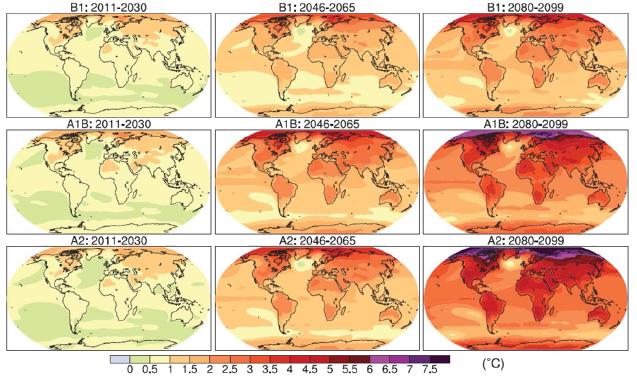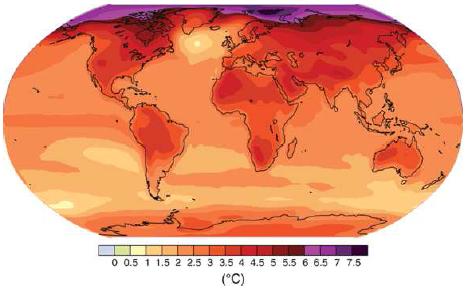Balance equation solution
Storyboard 
The equations for the temperature of the earth's surface, bottom and top of the atmosphere can be solved by disturbance techniques. This is assumed small variations in solar intensity, albedos and coverage factors and it is estimated how these affect the variation of these temperatures.
ID:(575, 0)
New earth temperature
Equation 
The new temperature T_{et} is calculated by adding the initial temperature T_e with the variation \delta T_e:
ID:(7605, 0)
New lower atmosphere temperature
Equation 
The new temperature T_{bt} is calculated by adding the initial temperature T_b with the variation \delta T_b:
ID:(7606, 0)
New upper atmosphere temperature
Equation 
The new temperature T_{tt} is calculated by adding the initial temperature T_t with the variation \delta T_t:
ID:(7607, 0)
Fundamentals of the model
Description 
Since the parameters of the model vary little around their mean values, a Taylor expansion can be performed around the mean values. This yields linear equations that can be solved exactly.
ID:(84, 0)
New intensity
Equation 
The new intensity I_{st} is calculated by adding the initial intensity I_s with the variation \delta I_s:
ID:(7604, 0)
Basic model of radiative flux
Image 
The following diagram illustrates the main radiative fluxes (visible and infrared) in a simplified Earth model:

This diagram represents, in a simplified manner, the interaction of radiation on Earth. Visible radiation from the sun reaches the Earth\'s surface, where it can be reflected back into space, absorbed by the Earth\'s surface and converted into infrared radiation, or absorbed by the atmosphere. In turn, the Earth emits infrared radiation into space.
These radiative fluxes are fundamental to understanding the energy balance of our planet and the processes that regulate climate.
ID:(7331, 0)
Assumption evolution of society
Description 
To simulate the future development of climate, four possible scenarios were assumed:
- A1: Rapid economic growth, energy consumption triples by 2100. Population increase to 9 billion by 2050 and subsequent slow decline.
- A2: Moderate economic growth, energy consumption increases gradually but triples by 2100. Continuous population increase to 15 billion by 2100.
- B1: Rapid economic growth, energy consumption decreases by 2100. Population increase to 9 billion by 2050 and subsequent slow decline.
- B2: Slower economic growth, energy consumption increases significantly but stabilizes by 2100. Slow population increase to 10 billion by 2100.
For each of these scenarios, the following are estimated:
- Energy consumption and the way it is generated.
- Production and type of food consumed.
Additionally, the generation of corresponding gases is estimated.
ID:(7324, 0)
Balance Equations
Description 
In the case of equilibrium, the following three radiative equilibrium equations hold:
(1 - a_a)(1 - \gamma_{\nu})I_s - \kappa (T_e - T_b) - \sigma\epsilon_eT_e^4 + \sigma\epsilon_b T_b^4 = 0
\kappa(T_e - T_b) + \gamma_i\sigma\epsilon_e T_e^4 - 2\sigma\epsilon_bT_b^4 = 0
(1 - a_a)\gamma_{\nu} + \sigma\epsilon_b T_b^4 - 2\sigma\epsilon_t T_t^4 = 0
where T_e is the temperature of the Earth, T_b is the temperature of the lower atmosphere, and T_t is the temperature of the upper atmosphere. Additionally, we have the average solar radiation I_s, the albedos of the atmosphere and Earth denoted by a_a and a_e respectively, $\gamma_{
u} and \gamma_i representing the coverage factors in the visible and infrared range, \epsilon_e and \epsilon_a representing the emissivity of Earth and the atmosphere, and \sigma$ as the Stefan-Boltzmann constant.
ID:(85, 0)
Approximate Equations
Description 
Using the approximations, we obtain for the equation that in a linear approximation is:
-\kappa(\delta T_e-\delta T_b)-4\sigma\epsilon_e T_e^3\delta T_e+4\sigma\epsilon_b T_b^3\delta T_b-\delta a_e(1-\gamma_{\nu})I_s-(1-a_e)\delta\gamma_{\nu}I_s=0
Similarly, for the second equation, we have:
\kappa(\delta T_e-\delta T_b)+\sigma\epsilon_e T_e^4\delta\gamma_i+4\gamma_i\sigma\epsilon_e T_e^3\delta T_e+4\sigma\epsilon_t T_t^3\delta T_t-8\sigma\epsilon_b T_b^3\delta T_b=0
And for the third equation:
-2\sigma \epsilon_t T_t^3\delta T_t+\sigma\epsilon_b T_b^3\delta T_b-\gamma_{\nu}I_s\delta a_a+(1-a_a) I_s\delta\gamma_i=0
These three equations form a system of linear equations to calculate the variations of the temperatures \delta T_e, \delta T_b, and \delta T_t in terms of the variations of the albedos \delta a_e and \delta a_a, and the coverage factors $\delta \gamma_{
u} and \delta \gamma_i$.
ID:(87, 0)
Model simulator
Description 
The radiative balance equations allow us to calculate the temperatures on the Earth\'s surface T_e, in the lower atmosphere T_b, and at the top T_t. These equations are represented as follows:
Equation 1: The change in temperature at the Earth\'s surface is calculated using the equation:
M_eC_e\displaystyle\frac{dT_e}{dt}=(1-a_e)(1-\gamma_v)I_s-\kappa(T_e-T_b)-\sigma\epsilon T_e^4+\sigma\epsilon T_b^4
where M_e is the mass of the Earth, C_e is the heat capacity of the Earth, a_e is the Earth\'s albedo, \gamma_v is the fraction of visible radiation absorbed by the atmosphere, I_s is the incident solar radiation, \kappa is the thermal conductivity, \sigma is the Stefan-Boltzmann constant, and \epsilon is the emissivity of the Earth.
Equation 2: The change in temperature in the lower atmosphere is calculated using the equation:
M_bC_b\displaystyle\frac{dT_b}{dt}=\kappa(T_e-T_b)+\gamma_i\sigma\epsilon T_e^4-2\sigma\epsilon T_b^4+\sigma\epsilon T_t^4=0
where M_b is the mass of the atmosphere, C_b is the heat capacity of the atmosphere, and \gamma_i is the fraction of infrared radiation absorbed by the atmosphere.
Equation 3: The change in temperature at the top of the atmosphere is calculated using the equation:
M_tC_t\displaystyle\frac{dT_t}{dt}=(1-a_a)\gamma_vI_s+\sigma\epsilon T_b^4-2\sigma\epsilon T_t^4=0
where M_t is the mass of the upper atmosphere and C_t is the heat capacity of the upper atmosphere.
These equations represent the balance between incident solar radiation, radiation emitted by the Earth, and radiation transferred between different layers of the Earth and the atmosphere. By solving these equations, we can obtain the temperatures in each of these layers.
ID:(6867, 0)
Numerical solution
Description 
The system of equations can be solved analytically. If we evaluate the expressions for the parameters of the current Earth condition (a_e = 0.152, a_a = 0.535, \gamma_{ u} = 0.421, \gamma_i=0.897, \kappa = 2.226 , \text{W/m}^2\text{K}^{-1}, \epsilon_e = \epsilon_b = \epsilon_t = 1, I_s = 342 , \text{W/m}^2, T_e = 14.8^\circ \text{C}, T_b = 1.79^\circ \text{C}, and T_t = -30.98^\circ \text{C}), we would have:
| \delta T_e = 0.240\delta I_s - 97.978\delta\gamma_v+123.671\delta \gamma_i - 84.112\delta a_e - 22.827\delta a_a |
| \delta T_b = 0.193\delta I_s - 66.120\delta \gamma_v + 136.209\delta \gamma_i - 64.106\delta a_e - 25.142\delta a_a |
| \delta T_t = 0.172\delta I_s - 23.693\delta \gamma_v + 99.662\delta \gamma_i-46.905\delta a_e - 40.745\delta a_a |
ID:(7319, 0)
Solución numérica, Temperatura terrestre
Equation 
La temperatura terrestre se puede estimar mediante:
$\delta T_e = 0.240\delta I_s - 97.978\delta\gamma_{
u}+123.671\delta \gamma_i - 84.112\delta a_e - 22.827\delta a_a$
$\delta T_b = 0.193\delta I_s - 66.120\delta \gamma_{
u} + 136.209\delta \gamma_i - 64.106\delta a_e - 25.142\delta a_a$
$\delta T_t = 0.172\delta I_s - 23.693\delta \gamma_{
u} + 99.662\delta \gamma_i-46.905\delta a_e - 40.745\delta a_a$
donde se asumieron los valores
Parámetros | Valor
-------------------|:---------:
a_e | 0.152
a_a | 0.535
$\gamma_{
u} | 0.421$
\gamma_i | 0.897
\kappa | 2.226W/m^2K
\epsilon_e | 1
\epsilon_b | 1
\epsilon_t | 1
I_s | 342W/m^2
T_e | 14.8^{\circ}C
T_b | 1.79^{\circ}C
T_t | -30.98^{\circ}C
ID:(7440, 0)
Solución numérica, Temperatura atmosferica (inferior)
Equation 
La temperatura terrestre se puede estimar mediante:
$\delta T_e = 0.240\delta I_s - 97.978\delta\gamma_{
u}+123.671\delta \gamma_i - 84.112\delta a_e - 22.827\delta a_a$
$\delta T_b = 0.193\delta I_s - 66.120\delta \gamma_{
u} + 136.209\delta \gamma_i - 64.106\delta a_e - 25.142\delta a_a$
$\delta T_t = 0.172\delta I_s - 23.693\delta \gamma_{
u} + 99.662\delta \gamma_i-46.905\delta a_e - 40.745\delta a_a$
donde se asumieron los valores
Parámetros | Valor
-------------------|:---------:
a_e | 0.152
a_a | 0.535
$\gamma_{
u} | 0.421$
\gamma_i | 0.897
\kappa | 2.226W/m^2K
\epsilon_e | 1
\epsilon_b | 1
\epsilon_t | 1
I_s | 342W/m^2
T_e | 14.8^{\circ}C
T_b | 1.79^{\circ}C
T_t | -30.98^{\circ}C
ID:(7441, 0)
Solución numérica, Temperatura atmosferica (superior)
Equation 
La temperatura terrestre se puede estimar mediante:
$\delta T_e = 0.240\delta I_s - 97.978\delta\gamma_{
u}+123.671\delta \gamma_i - 84.112\delta a_e - 22.827\delta a_a$
$\delta T_b = 0.193\delta I_s - 66.120\delta \gamma_{
u} + 136.209\delta \gamma_i - 64.106\delta a_e - 25.142\delta a_a$
$\delta T_t = 0.172\delta I_s - 23.693\delta \gamma_{
u} + 99.662\delta \gamma_i-46.905\delta a_e - 40.745\delta a_a$
donde se asumieron los valores
Parámetros | Valor
-------------------|:---------:
a_e | 0.152
a_a | 0.535
$\gamma_{
u} | 0.421$
\gamma_i | 0.897
\kappa | 2.226W/m^2K
\epsilon_e | 1
\epsilon_b | 1
\epsilon_t | 1
I_s | 342W/m^2
T_e | 14.8^{\circ}C
T_b | 1.79^{\circ}C
T_t | -30.98^{\circ}C
ID:(7442, 0)
Calentamiento Global bajo distintos escenarios
Image 
Si se consideran los distintos escenarios B1, A1B y A1 se puede estudiar la probable evolución de la temperatura sobre la superficie del planeta.

Calentamiento Global bajo distintos escenarios
5.3-------7.67.57.68.27.67.6-8.78.78.711.38.79.3-7.17.17.015.17.010.421-------535657415351-16418118782136110-5255295502433282356.0-------11.212.110.011.010.09.0-23.116.012.316.511.711.2-30.313.14.328.95.213.81.1-------1.50.50.31.20.60.0-0.80.40.00.9-0.4-0.2--2.10.40.00.2-1.0-0.5310-------416421415424377384-630452500598359505-7352892748892365976.7-------9.37.26.19.68.16.1-14.57.46.112.08.36.3-16.67.05.416.55.76.9
| Escenarios | 1990 | A1FI | A1B | A1T | A2 | B1 | B2 |
| Población (1E+9) | |||||||
| 2020 | |||||||
| 2050 | |||||||
| 2100 | |||||||
| GDP (1E+12 1990US$/yr) | |||||||
| 2020 | |||||||
| 2050 | |||||||
| 2100 | |||||||
| CO2, fosil (GtC/yr) | |||||||
| 2020 | |||||||
| 2050 | |||||||
| 2100 | |||||||
| CO2, agro (GtC/yr) | |||||||
| 2020 | |||||||
| 2050 | |||||||
| 2100 | |||||||
| Metano, (MtCH4/yr) | |||||||
| 2020 | |||||||
| 2050 | |||||||
| 2100 | |||||||
| NO, (MtN/yr) | |||||||
| 2020 | |||||||
| 2050 | |||||||
| 2100 |
ID:(7333, 0)
Calentamiento Global (ejemplo)
Image 
La siguiente gráfica muestra el calentamiento según zona geográfica:

Calentamiento Global (ejemplo)
ID:(7332, 0)
